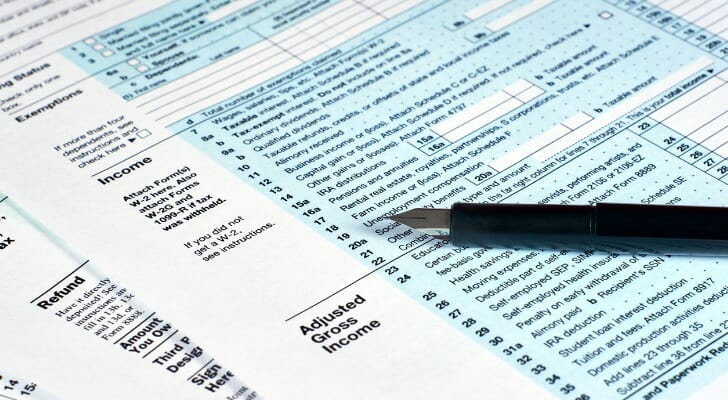If you have debt that is canceled by a lender, you may receive IRS Form 1099-C. Although you are no longer liable to repay the debt, you can’t simply forget about it. The IRS may consider the forgiven amount as taxable income, which means you may owe tax on the full amount that was forgiven. It is your responsibility as the borrower to report debt that was forgiven, so if you receive a 1099-C, be sure you accurately report any forgiven debt. Failure to do so could result in penalties and fees, so it’s important to familiarize yourself with this form and what it means.
Consider working with a financial advisor as you find the most efficient ways to handle your finances.
What Is IRS Form 1099-C?
IRS Form 1099-C is required by the IRS in some situations in which debt is forgiven or canceled. In particular, the IRS requires lenders to issue Form 1099-C when $600 or more in debt is forgiven or canceled. The lender’s only obligation is to send you and the IRS the form and not necessarily to guide you through the process of reporting the amount forgiven on your tax return.
What Form 1099-C Includes
Form 1099-C is much like any IRS form you may have seen in the past, with several boxes and sections for including all pertinent information. Be sure to check that the boxes on the form that the lender filled out are correct:
- Box 1: Date of identifiable event – The date the debt was forgiven or canceled.
- Box 2: Amount of debt discharged – The amount of debt that was discharged.
- Box 3: Interest, if included in box 2 – If the amount discharged included interest, report it here.
- Box 4: Debt description – Description of the debt that was canceled.
- Box 5: Check here if the debtor was personally liable for repayment of the debt – Check box to indicate whether you were personally liable for repayment.
- Box 6: Identifiable event code – This box provides codes to help describe the reason for cancellation.
- Box 7: Fair market value of property – This box is for providing the fair market value of any property associated with the cancellation in the event the loan was for a home, auto or other item associated with the debt.
What Form 1099-C Excludes
Although debt that is discharged is usually taxable, there are several scenarios in which that may not be the case. There are exceptions, among which are the following:
- Bankruptcy
- Insolvency
- Public service loan forgiveness
- Non-recourse debt
- Forgiven student loans (through 2025, due to the American Rescue Plan)
- Qualified farm indebtedness
- Qualified real property business indebtedness
- Qualified principal residence indebtedness
Other exclusions may apply. However, any forgiven debt that is to be excluded in these cases from your taxable income must still be reported to the IRS. That is done separately, on IRS Form 982.
How Form 1099-C Works

When you borrow money initially, you don’t have to pay taxes on it because the understanding is that you will pay the money back. But when debt is forgiven or canceled, that money becomes yours, so the IRS treats it as taxable income. Hence, forgiveness and cancellations affect the amount of federal income tax you owe and may reduce your refund or increase how much you owe.
Also note that although businesses are only required to send you Form 1099-C if $600 or more was forgiven or canceled, you are still responsible for reporting any amount that was forgiven. Hence, even if the amount forgiven is less than $600, you are still required to report it and pay any applicable taxes.
In general, you receive Form 1099-C when debt is forgiven or canceled, but there are some specific scenarios where you might not receive the form and don’t have to report forgiven debt as taxable income. For example, you might not receive it in the event of any of the following:
- Repossession or return of property to a lender
- Abandonment of property
- Foreclosure
- Modification of a loan on a primary residence
What to Do If You Receive Form 1099-C
Any lenders who forgave $600 of debt or more will likely start sending these forms in January. The IRS asks lenders to send them by Jan. 31 to allow enough time to include the amount forgiven on your tax return.
You do not need to submit Form 1099-C itself; you only have to report the amount on Form 1040, specifically on the Other Income line of Form 1040 or 1040-SR. Even though you are not submitting the actual Form 1099-C to the IRS, you should keep Form 1099-C for your records.
What to Do If You Don’t Receive Form 1099-C
There may be situations where you don’t receive a Form 1099-C, or you receive it after filing your taxes. In either case, you may still have a tax liability, so you should take the appropriate steps in order to pay what you owe.
First, remember that any lender that forgives $600 or more of debt should issue you a Form 1099-C, unless that debt falls into one of the exempted categories. If the lender doesn’t issue you this form, contact the lender and let them know you need the form for tax filing purposes.
This also brings up the possibility of receiving the form after filing your return. Once again, the fact that you didn’t receive the form on time doesn’t exempt you from paying the taxes you owe. In such cases, you can file an amended return after the fact.
Bottom Line

If you have debt forgiven or canceled and the amount is $600 or greater, the lender should send you IRS Form 1099-C to report the amount forgiven on your tax return. Once the debt is discharged, you should expect to pay income tax on any amount you haven’t repaid. And even if the amount is less than $600, you are still expected to report it and may have to pay income tax on the unpaid portion.
However, there are cases when discharged debt may not be subject to income tax. If you do receive Form 1099-C, though, be sure to report the amount forgiven and pay any applicable taxes. Failure to do so could result in penalties and fees.
Tax Planning Tips
- There are numerous financial issues around debt, which is why a financial advisor can be a valuable resource. Finding a qualified financial advisor doesn’t have to be hard. SmartAsset’s free tool matches you with up to three financial advisors who serve your area, and you can interview your advisor matches at no cost to decide which one is right for you. If you’re ready to find an advisor who can help you achieve your financial goals, get started now.
- Debt that is canceled or forgiven can affect how much you owe on your tax return. Use a tax return calculator to estimate how much you will owe.
- You can also use an income tax calculator to estimate the total amount of income tax you will owe this year.
Photo credit: ©iStock.com/Andrii Dodonov, ©iStock.com/Maksim Shchur, ©iStock.com/designer491
